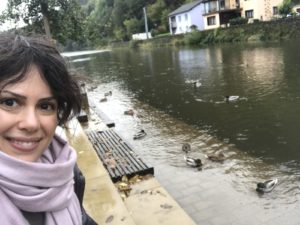
Boundaries and limits. Everyone had a pleasant and rich (hopefully) taste of these concepts in 2020. Time-wise, workwise, and heart-wise among many others.
Openness, tolerance and love. Everyone rightfully acknowledged the dearness of these feelings (probably) at the utmost level, again in 2020 – a year quite likely to be remembered as one of those soul-shattering years in the human history.
Why does that, especially openness, matter to us geoscientists?
I wrote this blog post as a sincere invitation for opening our hearts as well as opening our science and data. It also honours the new data policy of the World Meteorological Organization (WMO). It is called “Resolution 42” (referred to as Res. 42 hereinafter). If you are a fan of collaboration and you have ever struggled with accessing (hydrological) data, please read on.
Cooperation, collaboration and coordination are key
Research and academia have been growing and growing for many decades now. The constant pressure to generate knowledge and find solutions to scientific challenges has some side effects. It is imperative, for instance, to have that cool research idea published as quick as possible (well, at least before someone else reaches the same findings), or to publish papers with as few as possible co-authors (yes, this is unfortunately an argument that we still hear from time to time). However, is it what we need? Will it bring the effective solutions we strive? Are we, in research and academia, taking enough time to collaborate and share?
Maybe it is time to rethink and reimagine research. It is time to plant the seeds of a new world. All generations have a role to play. Anyone who believes they can change, should also believe that is also possible to create (at the societal level) a new culture, thus a new world too – one that reflects in its core openness, calmness, altruism, trust and tolerance universally. Deep changes usually happen behind the scenes and over very long time periods, but sudden and powerful shocks can also be very effective in pushing changes. Change is indeed a critical part of the evolution (mind and soul). As a 13th-century Persian poet puts it:
Try not resist the changes that come your way. Instead let life live through you. And do not worry that your life is turning upside down. How do you know that the side you are used to is better than the one to come? ― Shams Tabrizi
How can the (research) community on weather, climate, water and environment value and invest in cooperation, collaboration and coordination? Earth is a magnificent and complex enduring system with so much waiting to be discovered. The fundamental task of Earth geoscientists is to understand, analyse and predict the behaviour of this massive energetic system, from mantle to crust (lithosphere) and hydrosphere to atmosphere. All land and water across continents are connected and interdependent, and thus the (physical) processes across time and space. Research has brought forward the need for seamless Earth System models and predictions (Ruti et al., 2020; Clark et al., 2015). It has also pointed out to the need for Open Science.

Putting expectations and needs together (by Nilay Dogulu)
Open Science is the new black
The world of science officially entered a new era. It is creating a fundamental shift of anchors for perception and standards of how science is produced and shared. Data sharing and open access publishing are common terminus a quo for many, especially early career researchers. However, there are many other aspects that will guide our way into the waters of open science. Embracing the change towards openness requires knowledge, awareness and patience. Despite resistance that might still occur, the pace of advances supporting open science is likely to increase rapidly and fairly.
The geosciences community has been a strong ally for open science. After all, geoscience is all about Earth data (usually collected through field work and satellites) and mathematical models built to understand and/or predict Earth processes that impact societies in various ways. The efforts of EGU and Copernicus in this regard are worth mentioning (see also the webinars). If you want to get yourself acquainted with open science more, please take the opportunity to attend one of the many sessions at vEGU21 (registration is free for undergraduate or master student and, in some cases, for PhD candidates). This particular session is targeted at hydrologists: The evolving open-science landscape in geosciences: open data, software, publications and community initiatives. The EGU General Assembly 2020 (in the online format Sharing Geoscience Online) had also many interesting sessions, check them out here!
Open data policy has been recently at the forefront of Intergovernmental organisations’ agenda (UNESCO, 2020; WMO, 2020; ECMWF, 2020). The World Meteorological Organization (WMO) is a specialized agency of the United Nations (UN) whose mandate covers weather, climate and water resources. It enables international cooperation at a global scale through its technical commissions, programmes and regional offices as well as by synergistic partnerships. WMO has 187 Member States and supports national meteorological and hydrological services (NMMS) especially those of developing and least developed countries, to become full partners in global collaborative efforts. WMO contributes to policy formulation and assists Members with technology transfer, training for capacity development, collaboration on research and the application of weather, climate and water-related services worldwide. Earth data is the core of all such services’ provision at national and international levels. WMO is also responsible for facilitating the maintenance and expansion of observational networks; the free unrestricted exchange of the resulting data and information; and related capacity development and research. The quality of weather, climate and hydrological services worldwide are highly dependent on efficient coordination and regulation of the international exchange of Earth observation data.
Towards a new unified data policy, Res. 42
WMO has been a long-standing promoter of free and open data. WMO organized a global conference on Earth System Data Exchange in 16-19 November 2020. The fully virtual conference was attended by Representatives from NHMS, UN agencies and international organizations, space agencies, the private sector, global data users, academia, and development partner organizations.
Recognizing that the current WMO data policy resolutions – Res. 40 (Weather), Res. 25 (Water) and Res. 60 (Climate), adopted in 1995, 1999 and 2015, respectively – do not meet the needs of today’s fast evolving data landscape driven by the vast transformation in science and technology, this conference was a step forward in regards to review the WMO data requirements, arrangements and policies for enhancing Earth System monitoring, prediction and services. The conference was a great success in engaging a broad community in the discussions around shaping WMO’s new unified data policy, Res. 42 – currently being drafted for approval by WMO Executive Council and the World Meteorological Congress in 2021.
Prior to the conference, a series of well-attended preparatory workshops and stakeholder consultations were hosted. These were recorded and made available online (along with presentations of speakers) on the conference website. One of the consultations was dedicated to discuss key topics in order to achieve a fit-for-purpose representation of hydrology data sharing in Res. 42. The outcomes are summarized in a report, you can read here.
The conference was structured into four sessions aligned with the workshop themes: (1) the changing landscape of weather, climate and water data; (2) business models and data policy issues; (3) filling the gaps in global data coverage; and (4) data exchange for Earth system monitoring and prediction. The conference presentations were highly diverse, and followed by an open Q&A and panel discussion. An online poster session complemented the main conference programme which attracted more than 1200 attendees representing a wide range of stakeholders worldwide. The recordings of all sessions (and presentation materials) are freely accessible on the conference website. The final conference summary statement can be read from here.
The WMO Data Conference provided an extensive discussion venue for reaching a common understanding on the updated roles, requirements, and rules for international Earth data exchange for improved weather, climate and hydrological services. The discussions will certainly benefit formulation of a more robust and relevant data policy that will drive future global policy and practice. WMO Res. 42 presents an opportunity to broaden and enhance the free and unrestricted international exchange of diverse Earth observations and related data and products in line with WMO’s Strategic Plan 2020–2023 and Governance Reform. Res. 42 shall potentially benefit global research efforts by the scientific communities too. In Res. 42, there will be hopefully a specific attribution to utilization of data for research purposes within the framework of Open Science principles.
Cooperation, Collaboration & Coordination (by Nilay Dogulu)
In short, it all boils down to cooperation, collaboration and coordination! I would like to end by sharing yet another figure that summarizes how I envision the world and its actors in preparation for nourishing the new optimal culture (specifically for open science and data). As Lars Peter Riishøjgaard, the Deputy Director of the Infrastructure Department & the Director of the Earth System Branch at WMO, says:
As ever, the answer is 42!*
For more info on open hydrological data:
Please, have a look at this paper by Viglione et al., 2010 for more insights into hydrometeorological data exchange. If you want to read more about recent developments in hydrological data in general, check out this joint IAHS–WMO–UNESCO special issue in Hydrological Sciences Journal: “Hydrological data: Opportunities and barriers”. The Editorial by C. Cudennec, H. Lins, S. Uhlenbrook & B. Arheimer highlights the need for FAIR – Findable, Accessible, Interoperable, and Reusable data (Wilkinson et al., 2016) and SQUARE (i.e. those which Support QUality Action and REsearch) hydrological data to support hydrological information, knowledge and intelligence.
References:
- Clark, M. P., Fan, Y., Lawrence, D. M., Adam, J. C., Bolster, D., Gochis, D. J., … & Maxwell, R. M. (2015). Improving the representation of hydrologic processes in Earth System Models. Water Resources Research, 51(8), 5929-5956. https://doi.org/10.1002/2015WR017096
- Ruti, P. M., Tarasova, O., Keller, J. H., Carmichael, G., Hov, Ø., Jones, S. C., … & Bouchet, V. (2020). Advancing research for seamless earth system prediction. Bulletin of the American Meteorological Society, 101(1), E23-E35. https://doi.org/10.1175/BAMS-D-17-0302.1
- Viglione, A., Borga, M., Balabanis, P., & Blöschl, G. (2010). Barriers to the exchange of hydrometeorological data in Europe: Results from a survey and implications for data policy. Journal of Hydrology, 394(1-2), 63-77. https://doi.org/10.1016/j.jhydrol.2010.03.023
- Cudennec, C., Lins, H., Uhlenbrook, S., & Arheimer, B. (2020). Editorial–Towards FAIR and SQUARE hydrological data. Hydrological Sciences Journal, 65(5), 681-682. https://doi.org/10.1080/02626667.2020.1739397
- Wilkinson, M. D., Dumontier, M., Aalbersberg, I. J., Appleton, G., Axton, M., Baak, A., … & Mons, B. (2016). The FAIR Guiding Principles for scientific data management and stewardship. Scientific Data, 3(1), 1-9. https://doi.org/10.1038/sdata.2016.18
* The number 42 is, in The Hitchhiker’s Guide to the Galaxy by Douglas Adams, the “Answer to the Ultimate Question of Life, the Universe, and Everything”, calculated by an enormous supercomputer named Deep Thought over a period of 7.5 million years.”
About the author:
 Nilay Dogulu is a keen enthusiast for science-informed operational hydrology. Her research interests deal mainly with the applications of data-driven modelling techniques in hydrology. In her PhD research, Nilay explored the use of clustering methods for understanding catchment similarity and improving runoff predictions in ungauged basins. Nilay has acted as the Early Career Scientist Representative for the European Geosciences Union (EGU) HS Division (2017-19) and the International Association of Hydrological Sciences (IAHS) (2018-2022).
Nilay Dogulu is a keen enthusiast for science-informed operational hydrology. Her research interests deal mainly with the applications of data-driven modelling techniques in hydrology. In her PhD research, Nilay explored the use of clustering methods for understanding catchment similarity and improving runoff predictions in ungauged basins. Nilay has acted as the Early Career Scientist Representative for the European Geosciences Union (EGU) HS Division (2017-19) and the International Association of Hydrological Sciences (IAHS) (2018-2022).
Edited by Maria-Helena Ramos


Ayşen Terzi
Thanks to the author. I am delighted to hear these organizations and your support for open science. Go on please..